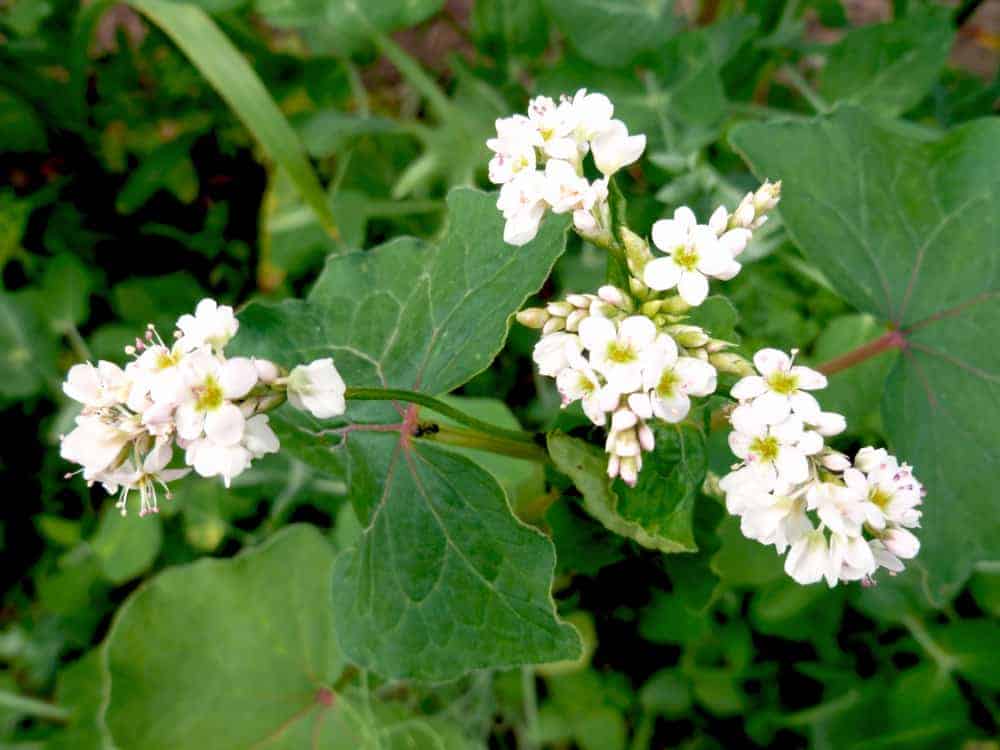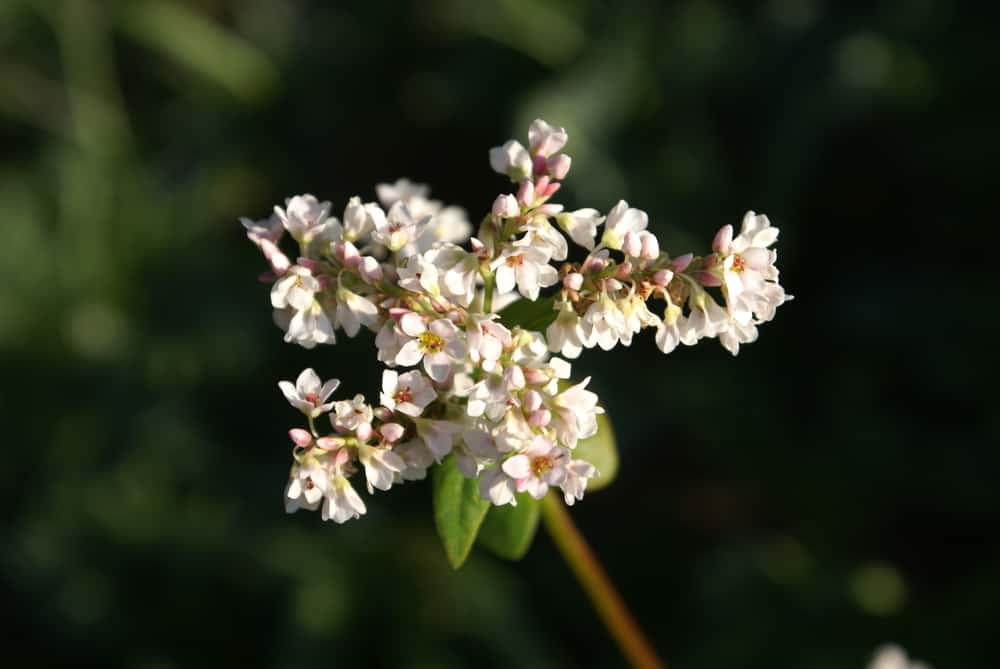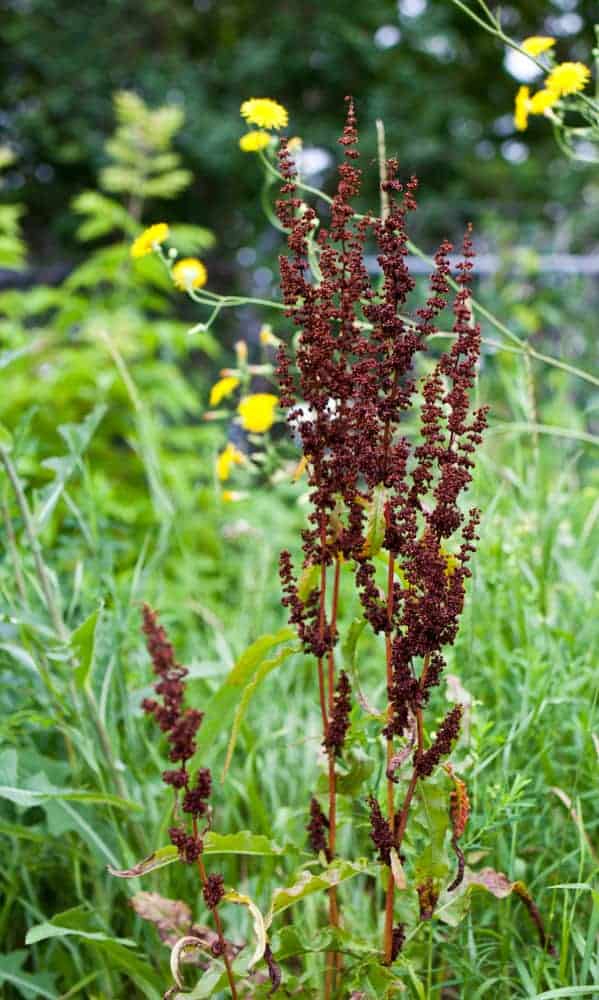Buckwheat plant was domesticated in northwestern China 3,000 years ago, Now becomes one of the Chinese favorite teas.
Over time, its cultivation was gradually spread across Russia and northern Europe and eventually came to the US as well. If you have decided to plant this fantastic plant in your garden, I have a few useful tips which will help you for sure.
Basic Data about Buckwheat Plant
Buckwheat plant (Fagopyrum esculentum) is an annual broadleaf pseudo-cereal and can grow equally during summer and cold season. It covers the soil very quickly and can produce up to three tons of dry plant material per one acre (4000 m2) in just two months.
Even though this crop thrives in cold and moist conditions, you can’t expect it survive sharp frost. Also, buckwheat is not particularly tolerant of hot, dry conditions and drought.
There are very few varieties of this grain in the US. Usually, you can see ‘common’ buckwheat, Canadian grown Mancan, and Canadian grown Manor. The original US type of buckwheat is Winsor Royal, but you can also find some commercial varieties such as Koto, Keukett, and Manisoba.
13 Reasons You Need Buckwheat Plant in Your Garden

- It is edible– Ripe seeds of this plant easily fall off. After removing the chaff, you can make flour of its seeds by using a grain mill. On the other hand, you can always grow it as micro-greens.
- It is a source of valuable nutrients– The great advantage of this type of flour is that it is entirely gluten-free, and has a lot of minerals and antioxidants. Thanks to a high concentration of amino acids, this plant is an excellent source of proteins.
- It attracts beneficial insects – By attracting honeybees and other pollinators, buckwheat will help to pollinate your veggies and flowers. In fact, this plant has a great symbiotic relationship with these beneficial insects. On the one hand, buckwheat flowers need bees as pollinators. On the other hand, its flowers provide insects with nectar which will help bees produce flavored buckwheat-honey.
- It supports smaller beneficial insects – Blooming buckwheat will help various beneficial insects, including hoverflies (Syrphid flies), lady beetles, insidious flower bugs, predatory wasps, tachinid flies, and minute pirate bugs. By providing food for females of these predators of aphids, buckwheat will deter pests far away from your potato, green beans, and broccoli.
- It is excellent animal fodder– Its clippings can be a favorite food for your chickens!
- It destroys weeds– Use it as an excellent method of weed control! The principle is simple. Buckwheat grows quickly and makes enough shade. That way it prevents the growth of most weeds. Plus, all compounds left in the soil after pulling out this plant, will suppress the germination of weed seeds by acting as a natural herbicide. You can count on buckwheat to effectively suppress sow-thistle, Canada thistle, leafy spurge, creeping jenny, quack-grass, perennial peppergrass, and Russian knapweed.
- It deters pests– If you scatter buckwheat seeds alongside sprouted seeds of various vegetable, it will take root very quickly and reach the height of 12 to 15 inches (30.5 – 38 cm) in just a couple of weeks. That way, this valuable plant will protect your flowers and veggies from flying pests which find it difficult to pass through its lush growth.
- It can be grown as a green manure crop– The only thing you need to do is to scatter seeds on a planting area or even fallow garden bed. Chop its green parts, add them to your compost pile, and let it enrich your soil as a natural fertilizer.
- It is a soil conditioner– Abundant roots of buckwheat will make topsoil as loose as most of the useful plants need.
- It improves soil– If you add calcium and phosphorous to the ground in your garden regularly, it can become enriched with these minerals, but plants have difficulties in taking them up. Buckwheat works as a so-called ‘phosphorus pump’ because it takes phosphorus from the soil and transforms it. When the mineral returns to the ground, it is plant-friendly, and your plants can use them.
- Its seeds are useful– You can use dried seeds to fill your traditional Japanese pillow. It can also be used as an excellent homemade heating pad or an aromatherapy eye pillow.
- It will reseed itself– You can choose to collect the seeds and control where it will grow the next season or let it fall wherever. The great thing is that you will spot new plants next year without making any effort.
- It can be used as a cover crop– It is green and soft, and you can use this plant to fill every open area in your garden which is too poor for other crops or veggies.
How to Plant Buckwheat in Your Garden
1. Best regions for growing buckwheat plants

Keep in mind that this quick-blooming plant doesn’t like hot and too dry weather conditions. In fact, you can produce it commercially only if you live in the northern states.
The reason is that high temperatures, especially at night, will reduce yields because increased heat causes ‘blasting’ of flowers when plants have a long period of blooming, and their blossoms fall off before forming seeds.
2. Seedbed preparation
Since this plant has a high-quality root system, timely preparation of a good seedbed is always an excellent investment.
Pick out firm seedbed to obtain uniform plants with a desirable percentage of essential nutrients. You want your buckwheat to grow rapidly as well as to reduce any damages caused by drought.
3. Select the Adequate Site
To achieve the best growth of your buckwheat plants, you should choose the soil which is not either too compacted or too sandy.
Experts say that you should avoid planting buckwheat at a field immediately after wheat harvesting, especially if you harvested this plant under wet conditions. Otherwise, you will have compaction problems with your new plants.
Moreover, planting buckwheat in compacted tire tracks is not a wise idea. If you do that, you will probably get plants stunted in growth.
4. Prepare the Soil
The excellent news is that you can sow buckwheat at low fertile soils such as loams, sandy loams, and silt loams. Surprisingly, your plants will have a lot of benefits if you choose the ground with a modest level of nitrogen.
When you decide to pick out an old pasture or empty field which has not been cultivated for years, you should start with deep plowing a couple of weeks before sowing. That way, you will improve the physical condition of the soil, destroy weeds, and retain the necessary level of moisture.
However, avoid sowing while the soil is wet since it can be too hard for new seeds. Buckwheat plants can tolerate moist soils to a certain level, but it prefers the well-drained ground. Also, it is noticed that it grows poorly on the land with too much limestone.
If you grow small grain or a cultivated crop at that field during the previous year, it will be enough to harrow the place. In any other case, you will need to plow the field. One more thing! Don’t forget to finish plowing and disking your garden by the end of June to retain necessary soil moisture.
5. Fertilizing
Your buckwheat will be tolerant of acidic conditions. Avoid using soluble nitrogen fertilizers since they can cause the growth of vegetative parts of the plants instead of seeds’ growth.
You can always add your own compost high in nutrients you got by the breakdown of organic materials. You won’t make a mistake if using compost made of winter cover crops ingredients such as rye and hairy vetch. They will maintain the fertility of the soil you plan to grow buckwheat on.
6. Rotations

Except for consuming, most gardeners sow buckwheat as a mid-summer cover crop to suppress excessive growth of weeds. If you plant it in late fall, it will kill all residue at the surface of the soil and provide soil cover.
7. Sowing
Since it is a fast-growing plant, you can begin planting it in late spring or during summer. If you start planting in spring, your plants will grow taller than those sowed later.
Always start sowing buckwheat after danger of frost passes. If you manage to avoid severe frost, you can expect it matures quickly. First flowers will show approximately a month after you sow seeds, and production of grain will start in two months on average.
To avoid high temperatures during the period when the seeds form, you should plant buckwheat as late as possible. That means that you should sow it at the last week of June if you live in northeastern states of the US, or later if living on the south.
Sow buckwheat at a depth of 0.5 to 1 inch (1.3 – 2.5 cm) by using a grain drill. Avoid putting your seed deeper than 1.5 inches (3.8 cm) into the soil.
In the average, you should sow 40 to 55 pounds (18 – 25 kg) of your buckwheat per acre. The rate can be lower if you have high-quality land or if the soil is too wet and cold. The same situation is when you poorly prepare the ground for sowing.
8. Where to purchase seeds
You can probably find quality buckwheat seeds in your local store. Some companies specialized for selling cover crop seeds are the cheapest source of seeds. Look for one of them at the Net. However, don’t try to sow toasted buckwheat grows you use for breakfast. Believe me; they won’t sprout, no matter what.
9. Plant establishment

One of the most significant advantages of sowing buckwheat is that this plant can compensate for lower seeding rates. In such a case, you can expect every plant develops more branches, and you will find more seeds per single blossom.
However, if you add too many seeds in one hole, your plants will become vulnerable to weeds until their canopies start filling in. Also, if stalks are too denser, they can become spindly and sensitive to wind blows and heavy rain.
10. Pest management

In general, buckwheat is highly resistant to pests and plant diseases. The residue of grass weeds, pigweed, and lambs quarters can cause some problems. Also, leaves of this crop are sensitive to diseases which cause fungi Ramularia and Rhizoctonia.
11. Harvesting

I really adore the fact that buckwheat blooms indeterminately. That means that you can expect to see flowers, ripe and unripe seeds at the same time until very late in the season.
When you spot that approximately 75% of the seeds are dark brown, you should cut their stems near the surface of the ground. Keep in mind that harvesting needs to start before the first frost. Otherwise, plant’s foliage will collapse, seeds will fall off the plant, and you will lose most of it.
To get mature seeds, you should lay plants on a sheet and beat them a few times with a stick while turning them over. Collect the separated seeds and chaff, and put them into a container. The best way to clean seeds is to put them in front of a window fan turned on at the highest possible speed. Use remained stalks as excellent organic mulch.


why is there a picture of dock under “Harvesting”? 😃
Can i use non food grade seeds that aren’t treated
After you harvest the greens what do you do with the remaining stems and soil in the container? Do you need to start with fresh germination mix or sterile mix for each new batch of greens you start? Thank you